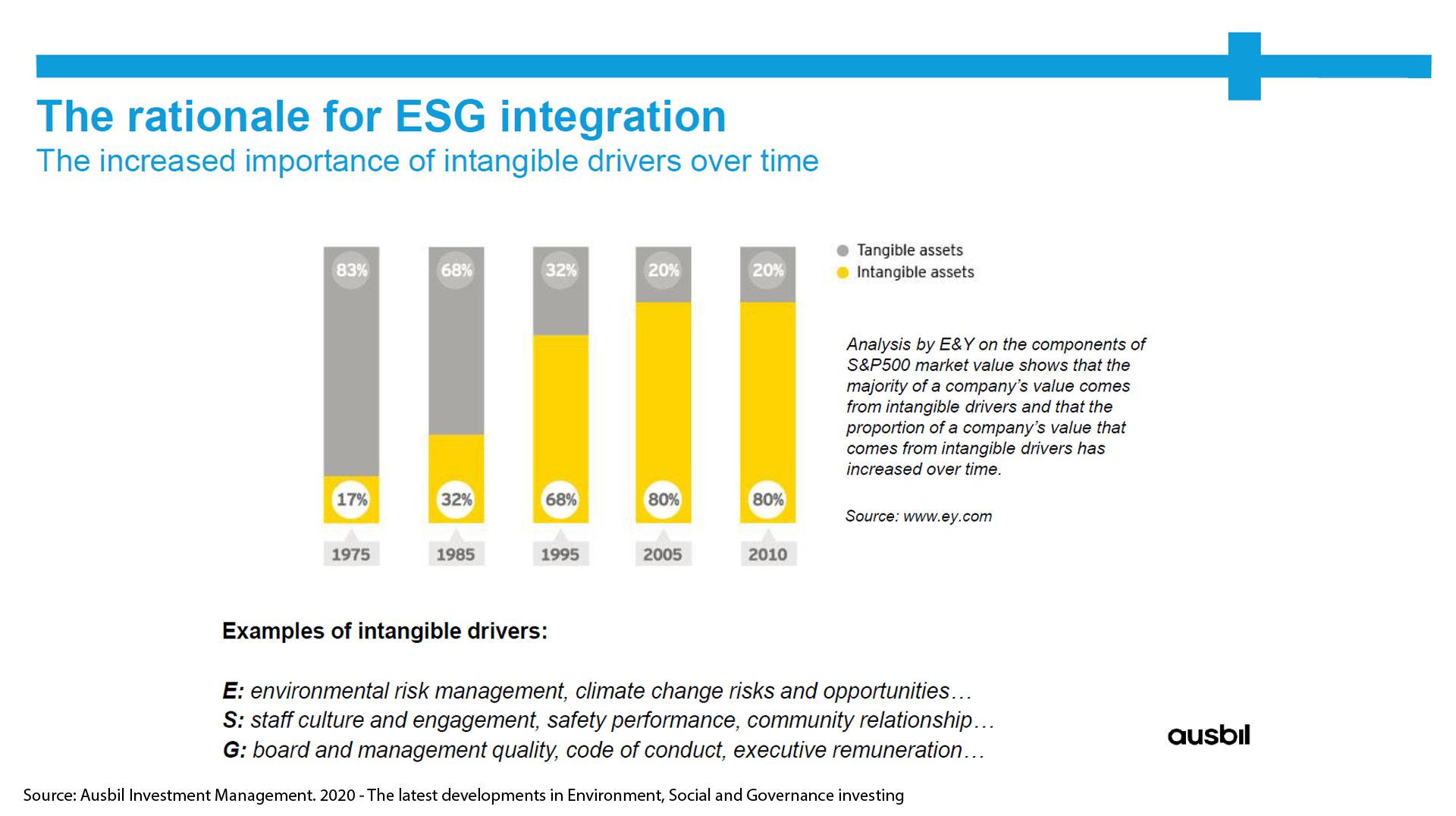Take outs
- There is greater regulatory push for companies to address climate change
- 49% of investors choose a managed fund or company based on ESG considerations
- Intangible drivers are increasing the value of companies now more than ever
Climate change is front and centre for those looking to develop responsible methods of investing. Responsible investing has evolved from ethical investment to an integration of environment, social and governance (ESG) factors.
Appearing on the Netwealth webinar, 2020 – The latest developments in Environment, Social and Governance investing, Ausbil’s Head of ESG Research, Måns Carlsson-Sweeny and Nicholas Varcoe discussed how climate change is a key environmental factor driving investment decisions, both now and in the future.
The growing importance
How a company upholds its ESG responsibilities have become vital in today’s age.
A 2018 survey by Legg Mason found 49% of investors choose a managed fund or company to invest in according to that managed fund or company’s ESG considerations.
Misconduct issues identified in the banking industry, underpayments in the franchising industry and even dam disasters in Brazil are just some of the ESG events that have had a significant impact on company share prices, with investors reluctant to buy into those that fail to align with their personal values.
“ESG has evolved over time,” Nicholas says.
“It started out as ethical investment where investors were screening out companies they do not like from an ethical perspective – typically, companies involved in gambling, tobacco and weapons – and they typically did so with no regard for returns. They wanted to invest with their hearts.
“If we fast forward to today, investors are increasingly integrating ESG in order to make better informed investment decisions.”
New direction
Companies with an avid focus on climate change and other ESG factors are helping drive an investment shift.
According to research by EY, intangible assets – i.e. ESG factors – are increasing companies’ values.
As demonstrated in the graph below, since 1975 there has been a steady increase whereby the majority of a S&P 500 company’s value comes from intangible drivers.

“Historically, the majority of the company’s value comes from net tangible assets, the grey bars. Now in 2020 the opposite is true. The majority of value comes from intangible drivers, which are things you can't always see in our financial statements,” Måns says.
“By assessing how companies are managing their intangible drivers, which are the large drivers of company valuation, you can naturally make better informed investment decisions.”
How companies are addressing climate change
Companies are pushing ahead in adopting new measures to respond to climate change and consequently are changing the paradigm for investors.
“The one interesting trend that we've seen in the last year or so is that while many governments are dragging their feet, companies themselves and also investors are moving ahead,” Måns says.
“In the last reporting that we just went through in February 2020, we saw more and more commentary around climate change by explicit companies. A number of companies have also set climate change commitments and CO2 reduction goals for the long-term, by 2050.”
Companies are increasingly introducing a net carbon footprint – a metric designed to track the change in the emissions intensity of the energy products supplied.
Shell is a prime example of a company leading the charge in this regard. The oil and gas “supermajor” has a clear trajectory set to reduce what’s known as scope one, two and three emissions: 20% by 2030, and 50% by 2050.
- Scope 1: reduce direct emissions provided by the burning of fuels of the emitter.
- Scope 2: reduce indirect emissions generated by the electricity consumed and purchased by the emitter.
- Scope 3: reduce indirect emissions provided by the emitter activity by owned and controlled by a different emitter from the one who reports on the emissions.
How investors are addressing climate change
According to research by France-headquartered EDHEC Business School, investors are quickly realising how climate change is disrupting markets and economies across the globe, further driving an investment shift.
“Following the financial crisis, global investors have increasingly recognised that the ability to generate long-term, sustainable financial returns depends on stable, well-governed social, environmental and economic systems,” Associate Professor of Finance, Gianfranco Gianfrate, says.
“Over the past decade, investors have specifically sought to gain a better understanding of how firms manage risks and opportunities through their climate change policies.”
In line with this, some investors are going so far as to create their own carbon footprint analysis whilst evaluating their investments, Måns notes.
“Carbon footprinting means measuring the emissions in their entire portfolio and then contrasting that to a benchmark. That means effectively, if [you’ve invested in] a lot of mining and energy companies, you might have a higher [than] average carbon emissions intensity metric than the benchmark,” he says.
Looking ahead
Climate change will continue to drive an investment shift as governments and other organisations, both in Australia and around the world, emphasise its importance by introducing a range of initiatives.
Some of these include:
1. The UN Sustainable Development Goals
The UN Sustainable Development Goals (SGDs) sets out 17 high-level sustainability goals for all countries to focus on in order to achieve a more sustainable world by 2030.
As per the UN’s website, these goals recognise that “ending poverty and other deprivations must go hand-in-hand with strategies that improve health and education, reduce inequality, and spur economic growth – all while tackling climate change and working to preserve our oceans and forests”.
An increasing push towards goal 13 – Climate Action – has become a staple in companies across the globe.
So much so, climate change has been flagged as a major economic issue by the World Economic Forum. In addition, the Paris Agreement, signed by more than 170 countries in 2016, seeks to reduce greenhouse gas emissions. For Australia, this means by 26-28% below 2005 levels by 2030.

Compare managed funds and models
Get the latest research data and commentary to search and compare managed funds and managed account models. See performance data, costs and use powerful filtering tools to identify funds by manager and asset classes.
2. TCFD
The Task Force on Climate-related Financial Disclosures (TCFD), launched by the Financial Stability Board (FSB), seeks to “develop voluntary, consistent climate-related financial risk disclosures for use by companies in providing information to investors, lenders, insurers, and other stakeholders”.
“The work and recommendations of the Task Force will help companies understand what financial markets want from disclosure in order to measure and respond to climate change risks, and encourage firms to align their disclosures with investors’ needs.”
There are four main areas covered by the TCFD, with each designed to interlink and inform one another:
- Governance
- Strategy
- Risk management
- Metrics and targets
“It's asking companies to outline how they believe they will be impacted by a world that is decarbonizing,” Nicholas says.
“The scenario analysis is probably the trickiest part. Each scenario needs to capture risks and opportunities for policy change, technology change and physical climate change.”
3. Regulatory push
Increased commentary on climate change coming from APRA, ASIC and the RBA is also driving an investment shift both now and in the future.
Over the past few years there has been a push for investors to vote on shareholder resolutions related to climate change, with this trend likely to continue moving forward.
“A number of companies, mainly in the energy and mining sectors such as Origin, BHP, Rio and Santos, have faced shareholder resolutions urging them to issue TCFD reports [and] set scope emissions targets,” Nicholas explains.
“This is a trend that is unlikely to go away soon and the level of support for shareholder resolutions has actually increased over the past year or so.”
4. Climate Action 100+
Launched in 2017, Climate Action 100+ is a global engagement initiative with 367 signatories and more than US$34 trillion in assets under management.
“In addition to AGM voting, investors can also engage with companies to make their voices heard…Climate Action 100+ is asking many of the things that the TCFD refers to,” Nicholas says.
Climate Action 100+ calls for companies to:
- Curb emissions
- Improve governance
- Strengthen climate-related financial disclosures (TCFD)
In conclusion, Nicholas notes a greater push for policy action will continue with regards to how the corporate world responds to climate change.
“The bottom line on climate change is this, we're foreseeing an inevitable policy change and, in the meantime, companies are preparing themselves for a decarbonized world,” he says.
To learn more
Watch our webinar, 2020 – The latest developments in Environment, Social and Governance investing, to find out more.
You may also enjoy

Portfolio Construction
Generating income and capital growth with unlisted infrastructure
Accessing unlisted infrastructure, like airports and toll roads, can be challenging due to the large capital outlay required. In this episode, we chat with Rory Shapiro, Associate Director at AMP Capital, to explore how investors can generate cashflow with less volatility using unlisted infrastructure. Learn how infrastructure responds to rising inflation and discover the outlook and emerging opportunities in the sector.

Portfolio Construction
Investing in the global leaders of tomorrow
Explore the factors driving performance in the global small and mid cap sector and its future outlook with James Abela and Maroun Younes from Fidelity. Discover the opportunities outside of Australia and why more investors should consider a global small and mid cap strategy.

Portfolio Construction
Is this time different for bonds?
Bond markets are adjusting after yields moved sharply higher in the first quarter of 2021. Schroders Fund Manager Kellie Wood explores the trends set to shape markets in 2021, and explains why she believes the repricing of bonds represents a healthy reset.
The information in this article is general in nature. Any financial advice it contains is general advice only and has been prepared without taking into account the objectives, financial situation or needs of any particular person. The article content is not intended to be a substitute for professional advice, so before you act on it you should determine its appropriateness having regard to your particular objectives, financial situation and needs, and seek any professional advice you require. Any reference to a particular investment is not a recommendation to buy, sell or hold the investment. The relevant disclosure document should be obtained from Netwealth and considered before deciding whether to acquire, dispose of, or to continue to hold, an investment in any Netwealth product.
This webinar guest is a financial product issuer. Netwealth and the guest have a commercial arrangement that enables investment in products managed by the guest through Netwealth’s platform. Under that arrangement, Netwealth may receive fees from the webinar guest. More information about the fees Netwealth receives is provided in our Financial Services Guide, which is available on our website or by contacting us.
